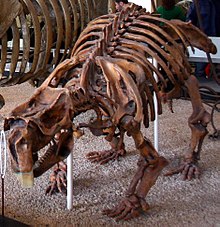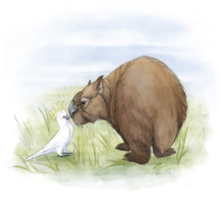大袋熊屬
外觀
| 大袋熊屬 化石時期:
| |
|---|---|

| |
| 化石 | |

| |
| 復原圖 | |
| 科學分類 | |
| 界: | 動物界 Animalia |
| 門: | 脊索動物門 Chordata |
| 綱: | 哺乳綱 Mammalia |
| 演化支: | 有袋類 Marsupialia |
| 目: | 雙門齒目 Diprotodontia |
| 科: | 袋熊科 Vombatidae |
| 屬: | †大袋熊屬 Phascolonus Owen, 1872 |
| 種 | |
| |
| 異名 | |
| |

大袋熊屬(學名:Phascolonus)是生存於上新世[1]至更新世時期澳洲的大型袋熊,於1859年由理察·歐文發表命名。本屬目前僅包含一種,即Phascolonus gigas,為目前已知體型最大的袋熊,體重可達200公斤(440磅)[2]至360公斤(790磅)[3]。大袋熊屬與其他袋熊物種差異最大的特徵在於其長板狀的上門牙以及有明顯向內凹陷的顱蓋[3]。牠們廣泛分佈於澳洲除西澳大利亞外的其他地區,偏好乾燥或半乾燥的內陸地區,以大量低營養價值的植物組織為食。雖然分佈廣泛,但推測大袋熊的生活環境仍然會選擇於淡水水源附近為主[4]。大量的大袋熊化石遺骸發現於南澳大利亞的卡拉伯納湖更新世年代的沉積物中[3]。和現存袋熊不同的是,大袋熊可能不具有挖掘地穴的能力[5]。大袋熊屬約於50,000至40,000年前更新世晚期的第四紀滅絕事件與其他澳洲巨型動物群一同走向滅絕,推測是由於人類的到來[4][6]。支序分類學分析顯示,大袋熊屬與其他大型袋熊如拉氏袋熊屬及Sedophascolomys為近親[3]。
參考文獻
[編輯]- ^ Louys, Julien. Wombats (Vombatidae: Marsupialia) from the Pliocene Chinchilla Sand, southeast Queensland, Australia. Alcheringa: An Australasian Journal of Palaeontology. 2015-07-03, 39 (3): 394–406 [2023-11-09]. ISSN 0311-5518. doi:10.1080/03115518.2015.1014737. (原始內容存檔於2023-11-15) (英語).
- ^ Long, John A.; Archer, Michael; Flannery, Tim & Hand, Suzanne. Prehistoric Mammals of Australia and New Guinea: One Hundred Million Years of Evolution. University of New South Wales Press. 2002: 161–162. ISBN 978-0-8018-7223-5. OCLC 49860159.
- ^ 3.0 3.1 3.2 3.3 Louys, Julien; Duval, Mathieu; Beck, Robin M. D.; Pease, Eleanor; Sobbe, Ian; Sands, Noel; Price, Gilbert J. Hautier, Lionel , 編. Cranial remains of Ramsayia magna from the Late Pleistocene of Australia and the evolution of gigantism in wombats (Marsupialia, Vombatidae). Papers in Palaeontology. November 2022, 8 (6) [2023-11-09]. ISSN 2056-2799. doi:10.1002/spp2.1475. hdl:10072/420259
 . (原始內容存檔於2023-04-01) (英語).
. (原始內容存檔於2023-04-01) (英語).
- ^ 4.0 4.1 Dawson, Lyndall. An ecophysiological approach to the extinction of large marsupial herbivores in middle and late Pleistocene Australia. Alcheringa: An Australasian Journal of Palaeontology. January 2006, 30 (sup1): 89–114 [2023-11-09]. ISSN 0311-5518. doi:10.1080/03115510609506857. (原始內容存檔於2023-04-02) (英語).
- ^ Woolnough, Andrew P.; Steele, Vernon R. The palaeoecology of the Vombatidae: did giant wombats burrow?. Mammal Review. March 2001, 31 (1): 33–45. ISSN 0305-1838. doi:10.1046/j.1365-2907.2001.00077.x (英語).
- ^ Hocknull, Scott A.; Lewis, Richard; Arnold, Lee J.; Pietsch, Tim; Joannes-Boyau, Renaud; Price, Gilbert J.; Moss, Patrick; Wood, Rachel; Dosseto, Anthony; Louys, Julien; Olley, Jon; Lawrence, Rochelle A. Extinction of eastern Sahul megafauna coincides with sustained environmental deterioration. Nature Communications. 2020-05-18, 11 (1): 2250. ISSN 2041-1723. PMC 7231803
 . PMID 32418985. doi:10.1038/s41467-020-15785-w (英語).
. PMID 32418985. doi:10.1038/s41467-020-15785-w (英語).
- Owen, Richard. Odontology. The Encyclopedia Britannica, or Dictionary of Arts, Sciences and General Literature 16 Eighth. 1858: 447, 450, figure 80.
- Stirling, Edward Charles & Zietz, Amandus Heinrich Christian. Preliminary notes on Phascolonus gigas, Owen [Phascolomys (Phascolonus) gigas, Owen] and its identity with Sceparnodon ramsayi Owen.. Transactions of the Royal Society of South Australia. 1899, 23: 123–135 [2023-11-09]. (原始內容存檔於2023-04-04) –透過BHL.
- Phascolonus gigas. The Recently Extinct Plants and Animals Database. [2022-09-14]. (原始內容存檔於2023-09-21).
- It’s a wombat, but not like you know it…. South Australian Museum. 2022-05-13 [2022-09-14]. (原始內容存檔於2023-11-12).



